Sicily Travel Guide
The largest island in the Mediterranean Sea, Sicily may be just a short hop from the Italian mainland, across the narrow strait of Messina, but it's worlds apart in atmosphere and attitude. Everything Italian seems a little more appetising here; not only the food, but the history and culture too.
For a long time, Sicily was ignored as a holiday destination, largely because of the mafia stranglehold and the poverty of the people. But today, the island is experiencing a tourism boom and a surge in development as the destructive influences of organised crime wane. Visitors discover that the Sicilian people are gracious and welcoming, and that the island itself offers natural and historic attractions of great beauty and interest.
The main cities of Palermo and Catania feature some of the most exquisite architecture in the world, a legacy of the many great civilisations that have vied for control of this strategically-situated island over the centuries, from Greeks, Romans, Arabs and Normans to French, Spanish and Italians. There are massive Romanesque cathedrals, the best-preserved Greek temples in the world and Roman amphitheatres, as well as magnificent Baroque palaces.
The continuous blue skies and temperate climate, lush vegetation and rich marine life all add to the island's appeal. Indeed, nature has given Sicily Europe's tallest active volcano, Mt Etna; a dramatic coastline; and fertile soil that gives forth much of the bounty on which the island's unique and delicious cuisine is based.
Sicily has a coastal Mediterranean climate of mild, wet winters and hot, dry summers. The mountainous interior has cooler temperatures, with snowfall during winter; while along the coast, winter temperatures average about 50F (10C), and summer temperatures about 84F (28C).
Things to do in Sicily
Sicily draws droves of sightseers to its beautiful beaches and countless ancient archaeological sites. Palermo, the capital, enjoys some fascinating historic Byzantine, Baroque and Norman buildings and artefacts, as well as some great museums. Sicily's second largest city, Catania, is spread beneath the shadow of glorious Mount Etna and is similar to Palermo in that it's not the most aesthetic. However, it has ancient remnants and historic gems interspersed in its urban sprawl.
Though visitors passing through Sicily's big cities will find plenty of diversions, most tourists will head to the smaller villages such as the stunningly picturesque Taormina, as they're where the real Sicilian charm can be found. Syracuse, once rivalling Athens as the most important city in the ancient Greek world, is perhaps an exception to this rule, because its historic quarter on the island of Ortygia is one of Sicily's greatest attractions. Must-see archaeological sites on Sicily include the Valley of the Temples, just outside Agrigento; the Roman ruins at Solunto, on the slopes of Mount Catalfamo; and, for those keen on diving, the underwater city of Ustica.
Sicily is also in demand for its stunning beaches, its dramatic, rocky coast giving way to some beautiful sandy shores. Rabbit Beach at Lampedusa has been called the best beach in the world, but it has some local competition: Mondello Bay, near Palermo, is very popular; San Vito lo Capo, between Trapani and Palermo, is one of the island's best resort areas; the Aeolian archipelago off Sicily's northeast coast boasts some magnificent beaches; and the southeastern coast of Sicily is beautifully unspoilt. It's warm enough for swimming between May and October.
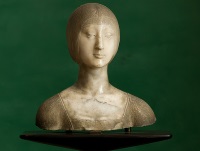
Galleria Regionale
Palermo's largest art museum is housed within the Gothic Palazzo Abatellis, built in 1488. The collection is fascinating and includes several particularly interesting works. The Bust of Eleanor of Aragon by Francesco Laurana, for example, dates from 1471 and is considered to be the epitome of Renaissance Sicilian sculpture; while the beautiful masterpiece painting Our Lady of the Annunciation is considered Antonello da Messina's greatest work. Also renowned is the chilling Triumph of Death fresco by an unknown 15th-century artist that covers an entire wall. The art is wonderful but so is the building, and visitors will get a good sense of the layout of the palace as they wander from room to room.

Marionette Museum
One of Palermo's most unique attractions is the engaging Museo Internazionale delle Marionette, a museum dedicated to the age-old Sicilian art of puppetry. The Opera dei Pupi of southern Italy is famous, with Palermo, Catania and Naples all having distinct marionette traditions. The museum was opened to preserve local traditions and the collection consists of more than 3,500 puppets.
Adjoining the museum is the library of Guiseppe Leggio, which houses about 3,000 books on puppetry and folk traditions; there is also a video library documenting theatrical folk performances and puppet shows from different cultures. Most of the antique puppets on display evoke Norman Sicily, representing chivalrous heroes and Saracen pirates, nobles and troubadours. The collection includes puppets from the Far East and even some 'Punch and Judy' dolls.
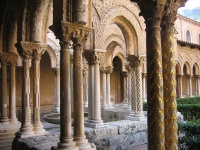
Monreale Cathedral
Of all the many architecturally beautiful and fascinating places of worship in Palermo, the most renowned is the 12th-century cathedral in the mountain suburb of Monreale. This dazzling cathedral is a mixture of Arab, Byzantine and Norman artistic styles, blending medieval Christian and Muslim architecture. The magnificent mosaics cover 68,243 square feet (6,340 sq m) of the cathedral's dome, and all of the walls on the interior are unsurpassed. The adjacent Benedictine abbey features a cloister with 228 carved stone columns, many inlaid with mosaics depicting scenes from Sicily's Norman history. Entrance to the breathtaking cathedral is free, but there are small admission charges for the Treasury, Cloisters and Terraces, which are worth exploring.
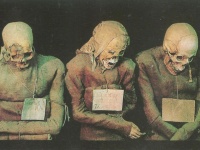
Capuchin Catacombs
The fascinating subterranean world of the Capuchin Catacombs contains the remains of about 8,000 inhabitants of Palermo. The friars began mummifying and embalming bodies of the city's nobles back in 1533, a tradition persisting for centuries until 1920. After embalming, the corpses were hung along the walls of the catacombs dressed in their best, such as the military officer in an 18th-century uniform complete with tricorn hat. The bodies are arranged according to profession, sex and age, with separate sections for virgins, children and lawyers, among other things. Cool and dimly lit, the atmosphere is one of respect and care for the ancestors. While quite emotional for some, it can be disturbing for others.
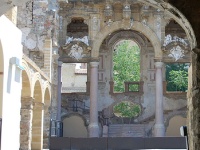
Palazzo Mirto
The excessive opulence of the Baroque period is best demonstrated in the magnificent Palazzo Mirto, which offers visitors to Palermo a glimpse into the lifestyle of Sicily's noble 19th-century families. Most of the princely rooms and salons are furnished with original artefacts, while visitors can also see the old stables and stagecoaches. The feeling of visiting a home is amplified by the fact that the palace is not thronged by tourists, many of whom don't know it exists. Signage and information is in Italian, so it might be worth getting a guide.
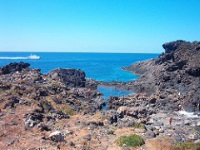
Ustica
An underwater city and a landscape of petrified black lava are the characteristics of the unusual little island of Ustica, which is just a short ferry ride from Palermo. The ancient volcanic island was once inhabited by the Phoenicians and often fell prey to pirate raids during the Middle Ages. There are many shipwrecks off the island and the Greeks believed it was inhabited by sirens that lured ships to their doom on the rocks.
The Greeks, Carthaginians and Romans all left their mark on the landscape too. Today, the island is a designated national marine park and its crystal-clear waters and undersea treasures, particularly the submerged ancient city of Osteodes, attract divers from all over the world. The snorkelling is also brilliant, as the waters around the island teem with marine life.
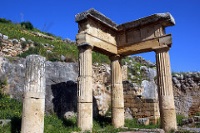
Solunto
The Roman ruins at Solunto overlook the coast near Santa Flavia on the slopes of Mount Catalfamo. The site was originally a Phoenician village, expanded by the Greeks who conquered it in 396 BC. By 255 BC it had fallen to the Romans, who rebuilt much of the original town. The ruins consist mainly of floors and the lower portions of walls and columns. Portions of mosaics and paintings are still visible and really exciting to stumble upon. There is an impressive view of the Gulf of Palermo from the hilltop above Solunto, and there is a small archaeological museum at the site. Travellers should note that most of the artefacts from Solunto are in Palermo's Regional Archaeological Museum.
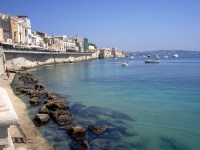
Ortygia
The Ponte Nuova connects the mainland city of Syracuse to the island of Ortygia, where most of the area's best sights are located. Greek colonists fortified Ortygia and the remains of the Temple of Apollo from 565 BC can still be visited in the Piazza Pancali. The cathedral in the nearby Piazza Duomo is uniquely made up of the original walls of a 5th-century BC Greek temple known as the Athenaion, and the mythical Spring of Arethusa lies near the sea and can be reached along Via Capodieci. There are medieval relics on the island too, including Maniaces Castle, dating from the 11th century.
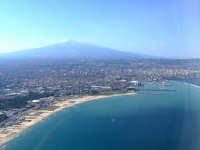
Catania
Catania was founded in 729 BC and is the second largest city in Sicily. Located in the shadow of Europe's highest volcano, Mount Etna, its elegant old buildings were constructed from white marble and black lava, many of which have since fallen into ruins or been destroyed by war, earthquakes and lava flows. There are two Roman amphitheatres, one reminiscent of Rome's Colosseum, and a 13th-century fortress and now museum, Ursino Castle. The cathedral contains some royal tombs and was built in the 11th century, though much of the historic downtown dates back to the 17th-century, which certainly earns the area its listing as a heritage site. Catania is regarded as the hottest city in Italy, with temperatures often soaring to 104F (40C).

Mount Etna
Sicily's greatest natural attraction is Mount Etna, an active volcano which has been spewing lava and shaking the earth for centuries. The craters below the summit can be reached from the town of Piano Provenzana at the base by bus or on foot. This town also serves as a ski resort in winter, while summer sees it shift into a base camp for hikers intent on enjoying the wooded scenery and exploring the area's interesting caverns. Various species of oak, pine and birch grow over the lower mountain slopes; toads, tortoises and lizards hide in the forest streams. Foxes, weasels and other small mammals stalk the forests, and a plethora of bird species fill the trees and the Gurrida Lake area.
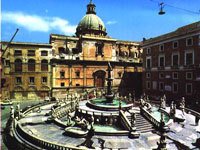
Palermo
Palermo, Sicily's capital, has some fascinating historic Byzantine, Baroque and Norman buildings and artefacts, as well as some great museums. It has remained a rich heart of arts and culture through much of its history, having endured for around 2,700 years. Some of the more breathtaking sites include the Palazzo dei Normanni, the Cattedrale and the simply stunning interiors found in the churches of La Martorana and the Capella Palatina. The creepy yet intriguing Capuchin Catacombs may fascinate those interested in the macabre, while the Botanic Garden is perfect for a stroll after catching a performance at the splendid Teatro Massimo.
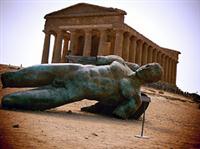
Valley of the Temples (Valle dei Templi)
The Valley of the Temples is one of Italy's oldest and most interesting archaeological sites, and is filled with some of the most outstanding examples of Magna Graecia architecture in the world. The Doric-style structures, built in the 5th century BC, are dedicated to gods and mythological characters, including, quite rarely, an imposing structure dedicated to Vulcan, god of fire. There are also some fascinating commemorative structures, built in celebration of Rome's victory over Carthage and in memory of Roman soldiers who were killed in the Second Punic War. In the tradition of Greco-Roman architecture of the period, all the structures face east to be illuminated by the rising sun.
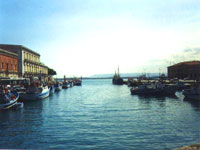
Syracuse
Found along Sicily's Ionian coastline, Syracuse once rivalled Athens as the most important city in the ancient Greek world. Its Greek heritage can still be found in the abundance of ruins and in the myths and legends centred particularly on its oldest quarter, the island of Ortygia. Renowned Greek mathematician, physicist, engineer, astronomer and inventor, Archimedes, once strode the streets here and, today, tourists can still get a feel for Syracuse's golden age of power and prosperity. As well as the Hellenic relics, Syracuse also boasts more than its fair share of Roman ruins and some fine medieval Gothic architecture and art. Most visitors prefer to make day trips to the city from the more comfortable resort areas nearby, where soft white beaches and fine wines can be enjoyed on the shores of the Ionian Sea.
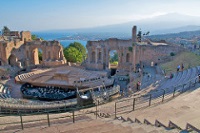
Taormina
Taormina has it all, from stunning surroundings, lovely nearby beaches and medieval charm to great shops, superb restaurants and interesting archaeological remains. Sicily's most famous holiday resort town, it boasts what is surely the most photographed view in Sicily: the beautiful ancient Greek amphitheatre with the sea and Mount Etna in the background. Taormina is ancient, inhabited since before 734 BC when the Greeks arrived on the Sicilian coast. Its winding medieval streets and tiny passages hide some great restaurants, cafes and ice-cream parlours, while the beach at Giardini-Naxos is particularly popular. The stone walls of the old city enclose some fascinating archaeological monuments and medieval palaces, including the Palazzo Santo Stefano.
Italy travel info
Electricity
Electrical current in Italy is 230 volts, 50Hz. A variety of plugs are in use, including the European-style two-pin plug.
Language
The official language of Italy is Italian. English is understood in the larger cities but not in the more remote parts of the country.
Money
The euro (EUR) is the official currency, which is divided into 100 cents. Those arriving in Italy with foreign currency can obtain euros through any bank, ATM or bureau de change. ATMs are widespread; credit cards are accepted in upmarket establishments and shops around the cities. Banks are closed on weekends but tend to have better rates than foreign exchange houses.
Tipping
Tipping is customary in Italy and 10 to 15 percent of the bill is acceptable in restaurants, unless a 15 percent service charge has already been added to the bill. Hotels add a service charge of 15 to 18 percent, but it is customary to tip the service staff extra. Italians rarely tip taxi drivers but a 5 to 10 percent tip is always appreciated.
Health
There are no specific health risks associated with travel to Italy and visitors should be able to travel without special vaccinations and medications. Medical facilities in Italy are good but travel insurance is still recommended for non-EU citizens, as medical attention can be expensive. EU citizens can make use of Italy's health services provided they have a European Health Insurance Card (EHIC), with UK citizens using their Global Health Insurance Card (GHIC). The GHIC replaced the EHIC for UK citizens and allows UK citizens access to state healthcare during visits to the EU. The GHIC is not valid in Norway, Iceland, Liechtenstein or Switzerland, nor is it an alternative to travel insurance. Although it should be possible to get most medication in Italy, travel authorities always suggest taking any prescribed medication in its original packaging with a signed and dated letter from a doctor.
Safety
Tourists are vulnerable to pickpocketing in the bigger cities, particularly on public transport, in crowded areas and around tourist sites. It's advisable to be careful when carrying large amounts of cash and valuables. Travellers should be particularly careful around Termini, which is the main train station in Rome. Visitors should be wary of groups of children, some of whom will distract attention while the others try to steal what they can. Strikes by transport workers take place regularly throughout Italy and delays are possible.
Local customs
In Italy, it's an offence to sit on steps and in courtyards near public buildings, including the main churches in Florence; eating and drinking in the vicinity should also be avoided. Shorts, vests or any other immodest clothing should not be worn inside churches.
Doing business
Italians can be very formal and old fashioned, but are also warm and welcoming. Face to face communication is best and often a third party introduction can speed initial negotiations. Business attire is formal and stylish, and handshakes are the norm, with first impressions counting a lot in Italy. Business cards are used. Visiting business people should also expect plenty of gesticulating, interruptions or people talking over each other. Unfortunately the bureaucracy in Italy can slow down deal-making. Business hours are usually 9am to 5pm Monday to Friday, but can vary according to season and region.
Duty free
Travellers over 17 years from non-EU countries do not have to pay duty on 200 cigarettes, 50 cigars or 250g of tobacco. Nor do they have to pay duty on 4 litres of wine, 16 lires of beer or 1 litre of spirits over 22 percent volume, or 2 litres of alcoholic beverages less than 22 percent volume. Other goods up to the value of €430 are also permitted (reduced to €175 for children under 15).
Travellers from EU countries travelling within the EU are limited to 110 litres of beer, 90 litres of wine, 10 litres of fortified wine, 10 litres of spirits and 1kg of tobacco, 800 cigarettes, 200 cigars or 400 cigarellos. Prohibited items include narcotic drugs, medicinal products, arms and weapons, explosives and protected animal and plant species.
Communications
The international access code for Italy is +39. Hotels, cafes and restaurants offering free WiFi are widely available; as international roaming costs can be high, purchasing a local prepaid SIM card can be a cheaper option.
Passport & Visa
The borderless region known as the Schengen Area includes the following countries: Austria, Belgium, Czech Republic, Denmark, Estonia, Finland, France, Germany, Greece, Hungary, Iceland, Italy, Latvia, Lithuania, Luxembourg, Malta, The Netherlands, Norway, Poland, Portugal, Slovakia, Slovenia, Spain, Sweden and Switzerland. All these countries issue a standard Schengen visa that has a multiple entry option, and which allows the holder to travel freely within the borders of all the aforementioned countries. All foreign passengers to Italy must also hold visible proof of financial means to support themselves while in the country, return or onward tickets, and the necessary travel documentation for their next destination. Visitors may be refused entry, either for public security, tranquillity, order or health reasons. Extensions of stay in Italy are possible by applying to local authorities. It is highly recommended that travellers' passport have at least six months' validity remaining after the intended date of departure from their travel destination. Immigration officials often apply different rules to those stated by travel agents and official sources.
Entry requirements
US citizens must have a passport that is valid for at least three months beyond their intended stay in Italy. No visa is required for stays of up to 90 days within a 180 day period.
UK citizens must have a passport that is valid for at least three months beyond their intended stay in Italy. No visa is required for stays of up to 90 days within a 180 day period.
Canadian citizens must have a passport that is valid for at least three months beyond their intended stay in Italy. No visa is required for stays of up to 90 days within a 180 day period.
Australian citizens must have a passport that is valid for three months beyond their intended stay in Italy. No visa is required for stays of up to 90 days within a 180 day period.
South African citizens must have a passport that is valid for three months beyond their intended stay, and a valid Schengen visa, to enter Italy.
Irish citizens must have a passport that is valid upon their arrival in Italy. No visa is required.
New Zealand citizens must have a passports valid for three months beyond period of intended stay in Italy. No visa is required for stays of up to 90 days within a 180 day period.
Useful contacts
www.enit.it
112 (General Emergencies), 113 (Police), 118 (Ambulance)Embassies / consulates in other countries
Italian Embassy, Washington DC, United States: +1 202 612 4400.
Italian Embassy, London, United Kingdom: +44 (0)20 7312 2200.
Italian Embassy, Ottawa, Canada: +1 613 232 2401.
Italian Embassy, Canberra, Australia: +61 (0)2 6273 3333.
Italian Embassy, Pretoria, South Africa: +27 (0)12 423 000.
Italian Embassy, Dublin, Ireland: +353 (0)1 660 1744.
Italian Embassy, Wellington, New Zealand: +64 (0)4 473 5339.
Embassies / consulates in Italy
United States Embassy, Rome: +39 06 46741.
British Embassy, Rome: +39 06 4220 0001/ 4220.
Canadian Embassy, Rome: +39 06 85444 2911.
Australian Embassy, Rome: +39 06 852 721.
South African Embassy, Rome: +39 06 852 541.
Irish Embassy, Rome: +39 06 585 2381.
New Zealand Embassy, Rome: +39 06 853 7501.



